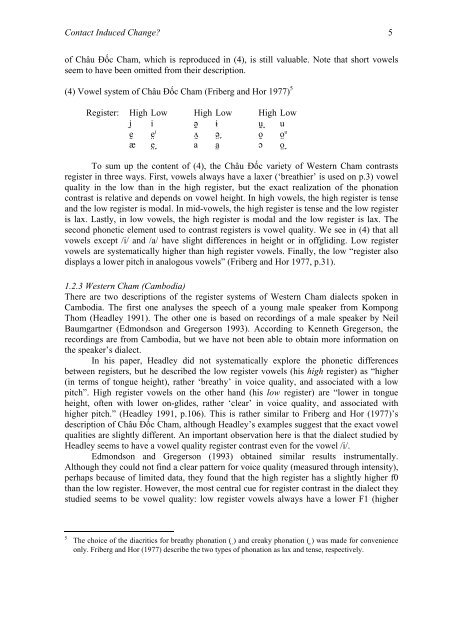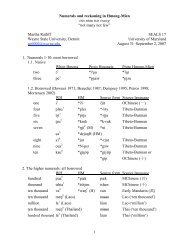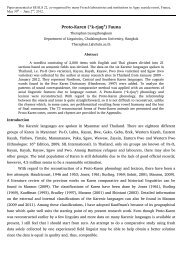proto-southwestern-tai revised: a new reconstruction - seals 22
proto-southwestern-tai revised: a new reconstruction - seals 22
proto-southwestern-tai revised: a new reconstruction - seals 22
Create successful ePaper yourself
Turn your PDF publications into a flip-book with our unique Google optimized e-Paper software.
Contact Induced Change? 5<br />
of Châu Đốc Cham, which is reproduced in (4), is still valuable. Note that short vowels<br />
seem to have been omitted from their description.<br />
(4) Vowel system of Châu Đốc Cham (Friberg and Hor 1977) 5<br />
Register: High Low High Low High Low<br />
i� i �� ɨ u� � u<br />
e� e� i �� �� � o� o� u<br />
æ e� � a a� � o� �<br />
To sum up the content of (4), the Châu Đốc variety of Western Cham contrasts<br />
register in three ways. First, vowels always have a laxer (‘breathier’ is used on p.3) vowel<br />
quality in the low than in the high register, but the exact realization of the phonation<br />
contrast is relative and depends on vowel height. In high vowels, the high register is tense<br />
and the low register is modal. In mid-vowels, the high register is tense and the low register<br />
is lax. Lastly, in low vowels, the high register is modal and the low register is lax. The<br />
second phonetic element used to contrast registers is vowel quality. We see in (4) that all<br />
vowels except /i/ and /a/ have slight differences in height or in offgliding. Low register<br />
vowels are systematically higher than high register vowels. Finally, the low “register also<br />
displays a lower pitch in analogous vowels” (Friberg and Hor 1977, p.31).<br />
1.2.3 Western Cham (Cambodia)<br />
There are two descriptions of the register systems of Western Cham dialects spoken in<br />
Cambodia. The first one analyses the speech of a young male speaker from Kompong<br />
Thom (Headley 1991). The other one is based on recordings of a male speaker by Neil<br />
Baumgartner (Edmondson and Gregerson 1993). According to Kenneth Gregerson, the<br />
recordings are from Cambodia, but we have not been able to ob<strong>tai</strong>n more information on<br />
the speaker’s dialect.<br />
In his paper, Headley did not systematically explore the phonetic differences<br />
between registers, but he described the low register vowels (his high register) as “higher<br />
(in terms of tongue height), rather ‘breathy’ in voice quality, and associated with a low<br />
pitch”. High register vowels on the other hand (his low register) are “lower in tongue<br />
height, often with lower on-glides, rather ‘clear’ in voice quality, and associated with<br />
higher pitch.” (Headley 1991, p.106). This is rather similar to Friberg and Hor (1977)’s<br />
description of Châu Đốc Cham, although Headley’s examples suggest that the exact vowel<br />
qualities are slightly different. An important observation here is that the dialect studied by<br />
Headley seems to have a vowel quality register contrast even for the vowel /i/.<br />
Edmondson and Gregerson (1993) ob<strong>tai</strong>ned similar results instrumentally.<br />
Although they could not find a clear pattern for voice quality (measured through intensity),<br />
perhaps because of limited data, they found that the high register has a slightly higher f0<br />
than the low register. However, the most central cue for register contrast in the dialect they<br />
studied seems to be vowel quality: low register vowels always have a lower F1 (higher<br />
5 The choice of the diacritics for breathy phonation ( �) and creaky phonation ( �) was made for convenience<br />
only. Friberg and Hor (1977) describe the two types of phonation as lax and tense, respectively.





